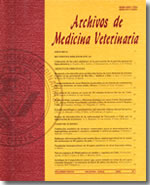Histochemical, morphometrical and metabolic characteristics of the Gluteus medius muscle from horses in training for jumping competition
Main Article Content
Abstract
Biopsies were taken at a depth of 3 and 6 cm from the Gluteus medius muscle of 7 mares and 3 castrated male horses. The animals were 4 years old and submitted to a previous specific training program for jumping during 6 months. The samples were analysed by the mATPase miofibrillar technique to determine the fibrillar composition, and by the NADH-TR technique to determine the oxidative capacity of the fibres. In addition, the fibre metabolic activity was determined by enzyme activities of the citrate synthetase (CS), 3-OH-acil CoA dehydrogenase (HAD), lactic dehydrogenase (LDH) and creatinkinase (CK).
The averages obtained for the fibrillar composition were 14, 28, 41 and 17% at 3 cm depth and 25, 30, 34 and 10% at 6 cm depth for oxidative type I, IIA, IIB and non oxidative IIB fibres, respectively. The fibrillar composition varied in relation to the depth of the biopsy. Type l and type II B fibre percentages showed significant differences between 3 and 6 cm. Type IIA fibres were similar in percentage at both depths whilst, oxidative and non oxidative fibres type IIB showed a statistically significant difference in percentage of fibrillar composition at both biopsy depths. The area of the muscle fibres at 3cm depth was 2191; 3466 and 5578 mm2for fibres type l, IIA and IIB, respectively and the lesser diameters were 19; 24 and 30 for fibres type l, IIA and IIB, respectively. The area of the fibres at 6 cm depth was 2433; 3929 y 5558 mm2 and the lesser diameters were 20; 25 y 30 for fibres I, IIA and IIB, respectively.
The activity of CS, HAD, LDH, and CK enzymes was 817, 243, 1.20 and 1.80 U/mg protein at 3 cm depth and 1479, 542, 1.58 and 3.30 at 6 cm depth. The activities of CS and HAD enzymes were significantly different between depths during the training period.
These results show that the training produced changes in the fibrillar composition and metabolic capacity of the Gluteus medius in horses prepared for jumping competition.
Significant differences were obtained in the fibrillar composition and enzymatic activities when comparing pre-training and post-training data.

